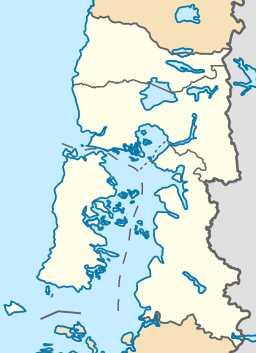Puyehue Lake
| Puyehue Lake | |
|---|---|
 View of the lake with Puyehue volcano in the background | |
| Coordinates | 40°41′01″S 72°27′46″W / 40.68361°S 72.46278°W |
| Primary inflows | Gol-Gol River |
| Primary outflows | Pilmaiquén River |
| Catchment area | 1,267 km2 (489 sq mi) |
| Basin countries | Chile |
| Max. length | 23 km (14 mi) |
| Max. width | 11.5 km (7.1 mi) |
| Surface area | 157 km2 (61 sq mi)[1] |
| Max. depth | 123 m (404 ft)[2] |
| Water volume | 12.6 km3 (10,200,000 acre⋅ft)[2] |
| Surface elevation | 212 m (696 ft)[1] |
| Islands | Fresia Island, Cuicui Islands |
| Settlements | Entre Lagos |
| References | Cuenca del río Bueno[1] |
Puyehue Lake (Spanish pronunciation: [puˈjewe]), (Mapudungun: puye, "small fish" and hue, "place"[3]) is an Andean piedmont lake on the border of Los Lagos Region with Los Ríos Region of Chile.
Puyehue is a lake of glacial origin. Several times during the Pleistocene glaciations, the lake depression was occupied by a large glacial lobe of the Patagonian Ice Sheet, which formed a series of moraines along its western shore. The lake has an east–west elongated shape with Fresia Island in the middle and two minor peninsulas pointing toward the island, one from the north and one from the south. The lake has a remarkably smooth shoreline, with only one inlet of significance: Futacullín Bay on the south.[1] Entre Lagos at the western end is the only town on the lake.
As with most other lakes of southern Chile, Puyehue Lake acts as a sediment trap for material from the Andes. Sediment cores taken from Puyehue Lake in 2001 and 2002 have been interpreted as supporting the existence of the Little Ice Age in the Southern Hemisphere.[4] A longer sediment core from the same site was used to reconstruct the evolution of the lake and its drainage basin during the last 18,000 years.[5][6][7]
At the time the glacier occupying the Puyhue basin had retreated during deglaciation as to calv at a proglacial Puyehue Lake the glacier at Rupanco basin (40°49' S) was at its maximum extent. For a time meltwater from the Rupanco glacier flowed north into Puyehue Lake.[8]
The 2011 Puyehue Volcano eruption polluted the Golgol River, a source of the lake, killing fish. Pyroclastic material reached Puyehue Lake through river transport, which resulted in the deposition of a layer of volcanic ash at the bottom of the lake.[9][10]

In the 16th century the lake was known to the Spanish as Llobén, from the Huilliche word of llofën meaning "abundant and continuous rain."[11]
References
[edit]- ^ a b c d Cuenca del río Bueno Archived 2015-09-24 at the Wayback Machine
- ^ a b Campos, H., Steffen, W., Agüero, G., Parra, O., Zúñiga, L., 1989. Estudios limnologicos en el Lago Puyehue (Chile): morfometria, factores fisicos y quimicos, plancton y productividad primaria. Medio Ambiente 10, 36–53.
- ^ de Moesbach, Ernesto Wilhelm (2016) [1944]. Voz de Arauco (in Spanish). Santiago: Ceibo. p. 186. ISBN 978-956-359-051-7.
- ^ Bertrand, Sébastien (2005). "Temporal evolution of sediment supply in Lago Puyehue (Southern Chile) during the last 600 yr and its climatic significance". Quaternary Research. 64 (2): 163–175. Bibcode:2005QuRes..64..163B. doi:10.1016/j.yqres.2005.06.005.
- ^ De Batist, Marc; Fagel, Nathalie; Loutre, Marie-France; Chapron, Emmanuel (2007). "A 17,900-year multi-proxy lacustrine record of Lago Puyehue (Chilean Lake District): introduction". Journal of Paleolimnology. 39 (2): 151–161. doi:10.1007/s10933-007-9113-2.
- ^ Bertrand, Sébastien; Sterken, Mieke; Vargas-Ramirez, Lourdes; De Batist, Marc; Vyverman, Wim; Lepoint, Gilles; Fagel, Nathalie (2010). "Bulk organic geochemistry of sediments from Puyehue Lake and its watershed (Chile, 40°S): Implications for paleoenvironmental reconstructions". Palaeogeography, Palaeoclimatology, Palaeoecology. 294 (1–2): 56–71. Bibcode:2010PPP...294...56B. doi:10.1016/j.palaeo.2009.03.012. hdl:1912/2742.
- ^ Moernaut, Jasper; De Batist, Marc; Charlet, Francois; Heirman, Katrien; Chapron, Emmanuel; Pino, Mario; Brümmer, Robert; Urrutia, Roberto (2007). "Giant earthquakes in South-Central Chile revealed by Holocene mass-wasting events in Lake Puyehue". Sedimentary Geology. 195 (3–4): 239–256. Bibcode:2007SedG..195..239M. doi:10.1016/j.sedgeo.2006.08.005.
- ^ Heirman, Katrien; De Batist, Marc; Charlet, Francois; Moernaut, Jasper; Chapron, Emmanuel; Brümmer, Robert; Pino, Mario; Urrutia, Roberto (2011). "Detailed seismic stratigraphy of Lago Puyehue: implications for the mode and timing of glacier retreat in the Chilean Lake District". Journal of Quaternary Science. 26 (7): 665–674. Bibcode:2011JQS....26..665H. doi:10.1002/jqs.1491.
- ^ Lago Puyehue tiene 10 centímetros de piedra pómez en el fondo tras erupción, Austral de Osorno, 2 de diciembre de 2014.
- ^ Bertrand, Sébastien; Daga, Romina; Bedert, Robin; Fontijn, Karen (2014). "Deposition of the 2011-2012 Cordón Caulle tephra (Chile, 40°S) in lake sediments: Implications for tephrochronology and volcanology". Journal of Geophysical Research: Earth Surface. 119 (12): 2555–2573. Bibcode:2014JGRF..119.2555B. doi:10.1002/2014JF003321. hdl:11336/180546.
- ^ Bernales Lillo, Mario (1984). "Aspectos diacrónicos en la toponimia de Valdivia". Anales de la Universidad de Chile (in Spanish). 5 (5): 79–94.

